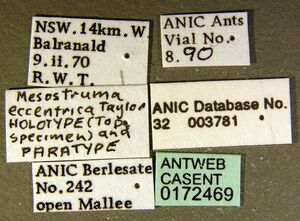Mesostruma eccentrica
| Mesostruma eccentrica | |
|---|---|

| |
| Scientific classification | |
| Kingdom: | Animalia |
| Phylum: | Arthropoda |
| Class: | Insecta |
| Order: | Hymenoptera |
| Family: | Formicidae |
| Subfamily: | Myrmicinae |
| Tribe: | Attini |
| Genus: | Mesostruma |
| Species: | M. eccentrica |
| Binomial name | |
| Mesostruma eccentrica Taylor, 1973 | |
In WA this ant has been collected from bark traps on Wandoo trunks at Dryandra and in litter at Westdale in the eastern Darling Range. (Heterick 2009)
Identification
This species is immediately recognisable by the presence of distinct teeth or short spines on the pronotal angles combined with the absence of wing-like projections on the lateral surfaces of the postpetiole. It shares the pronotal teeth with Mesostruma laevigata and is the only species in the genus which lacks postpetiolar wings.
Keys including this Species
- Key to Australian Mesostruma Species
- Key to Mesostruma of the southwestern Australian Botanical Province
Distribution
Heterick (2009) - Widely distributed throughout southern Australia.
Latitudinal Distribution Pattern
Latitudinal Range: -29.81666667° to -36°.
| North Temperate |
North Subtropical |
Tropical | South Subtropical |
South Temperate |
- Source: AntMaps
Distribution based on Regional Taxon Lists
Australasian Region: Australia (type locality).
Distribution based on AntMaps
Distribution based on AntWeb specimens
Check data from AntWeb
Countries Occupied
| Number of countries occupied by this species based on AntWiki Regional Taxon Lists. In general, fewer countries occupied indicates a narrower range, while more countries indicates a more widespread species. |

|
Estimated Abundance
| Relative abundance based on number of AntMaps records per species (this species within the purple bar). Fewer records (to the left) indicates a less abundant/encountered species while more records (to the right) indicates more abundant/encountered species. |

|
Biology
|
Castes
Worker
Images from AntWeb
   
| |
| Worker. Specimen code casent0172469. Photographer April Nobile, uploaded by California Academy of Sciences. | Owned by ANIC, Canberra, Australia. |
Images from AntWeb
   
| |
| Holotype of Mesostruma eccentrica. Worker. Specimen code casent0172468. Photographer April Nobile, uploaded by California Academy of Sciences. | Owned by ANIC, Canberra, Australia. |
Queen
Images from AntWeb
   
| |
| Queen (alate/dealate). Specimen code casent0172470. Photographer April Nobile, uploaded by California Academy of Sciences. | Owned by ANIC, Canberra, Australia. |
Nomenclature
The following information is derived from Barry Bolton's Online Catalogue of the Ants of the World.
- eccentrica. Mesostruma eccentrica Taylor, 1973: 31, pl. 2 (w.q.) AUSTRALIA. See also: Shattuck, in Bolton, 2000: 50.
Type Material
- Holotype, worker, 14km W Balranald, New South Wales, Australia, 9 February 1970, Taylor,R.W., ANIC32-015703, Australian National Insect Collection.
- Paratype, 10 workers, 14km W Balranald, New South Wales, Australia, 9 February 1970, Taylor,R.W., ANIC32-003781, Australian National Insect Collection.
- Paratype, 2 workers, 14km W Balranald, New South Wales, Australia, 9 February 1970, Taylor,R.W., The Natural History Museum.
- Paratype, 2 workers, 14km W Balranald, New South Wales, Australia, 9 February 1970, Taylor,R.W., Museum of Comparative Zoology.
- Paratype, 2 workers, 14km W Balranald, New South Wales, Australia, 9 February 1970, Taylor,R.W., South Australian Museum.
Unless otherwise noted the text for the remainder of this section is reported from the publication that includes the original description.
Description
Worker
Shattuck (2000) - TL 2.8 - 4.2, HL 0.61 - 0.90, HW 0.59 - 0.84, CI 90 - 96, ML 0.25 - 0.34, MI 35 - 40, SL 0.37 - 0.50, SI 57 - 63, PW 0.38 - 0.60, AL 0.72 - 1.10. Head relatively broad (CI >= 90), its posterior margin concave. In dorsal view the anterolateral corners of pronotum armed with distinct teeth or short spines. Dorsum of mesosoma with shallow foveolate punctures of varying densities (more widely spaced medially, more densely spaced laterally), the area between the punctures with weak, indistinct sculpturing. Propodeal lamellae reduced to thin carinae. Sculpturing on the metaplerual gland bulb consisting of scattered rugae over a reticulate-punctate surface. Lateral surfaces of postpetiole rounded. First gastral segment immediately posterior of the postpetiole with evenly spaced, short rugae. Body colour yellow-red, petiole with light infuscation, legs slightly lighter.
References
- Bolton, B. 2000. The ant tribe Dacetini. Mem. Am. Entomol. Inst. 65: 1-1028 (page 50, see also)
- Cantone S. 2018. Winged Ants, The queen. Dichotomous key to genera of winged female ants in the World. The Wings of Ants: morphological and systematic relationships (self-published).
- Heterick, B. E. 2009. A guide to the ants of South-western Australia. Records of the Western Australian Museum, Supplement 76:1-206.
- Heterick, B.E. 2021. A guide to the ants of Western Australia. Part I: Systematics. Records of the Western Australian Museum, Supplement 86, 1-245 (doi:10.18195/issn.0313-122x.86.2021.001-245).
- Heterick, B.E. 2022. A guide to the ants of Western Australia. Part II: Distribution and biology. Records of the Western Australian Museum, supplement 86: 247-510 (doi:10.18195/issn.0313-122x.86.2022.247-510).
- Shattuck, S. O. 2000. Genus Colobostruma. Genus Mesostruma. Genus Epopostruma. Pp. 31-67 in: Bolton, B. The ant tribe Dacetini. Mem. Am. Entomol. Inst. 65: 1-1028 (page 63, worker, queen described)
- Taylor, R. W. 1973. Ants of the Australian genus Mesostruma Brown (Hymenoptera: Formicidae). J. Aust. Entomol. Soc. 12: 24-38 (page 31, pl. 2, worker, queen described)
References based on Global Ant Biodiversity Informatics
- Bolton, B. 2000. The Ant Tribe Dacetini. Memoirs of the American Entomological Institute 65
- Heterick B. E. 2009. A guide to the ants of south-western Australia. Records of the Western Australian Museum Supplement 76: 1-206.
- Taylor R. W., and D. R. Brown. 1985. Formicoidea. Zoological Catalogue of Australia 2: 1-149.


